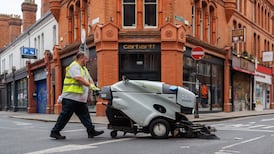Mould is the latest problem facing workers already bombarded by chemicals from office equipment, Prof Wallace Hayes tells Dick Ahlstrom
Office politics and staff rivalry aren't the only hidden dangers lurking in your office. There might also be fungal spores or bacteria carried by the ventilation system or a cocktail of complex chemicals arising from the carpets or furnishings.
The safety - or otherwise - of the modern workplace comes up for discussion this afternoon when noted US toxicologist, Prof Wallace Hayes, delivers the inaugural Philip Chambers lecture organised by the Irish Society of Toxicology.
Western societies developed safety systems to deal with the more obvious hazards found in steel mills, mines and manufacturing plants.
The picture is changing, however, as developed economies reduce involvement in manufacturing and move towards service industries. "One of the issues in the US and western Europe is we are moving away from an industrial context," Prof Hayes told The Irish Times.
Yet if western companies are relocating plants to developing countries, workers there are entitled to the same workplace protections afforded to western workers, he added. "We have to maintain the same level of standards as these facilities develop," he believes.
Ironically, while we expect workplace hazards in an industrial context, we don't usually expect them in the office, said Hayes, a toxicologist with more than 30 years' experience. He is based at the Department of Environmental Health in the Harvard School of Public Health in Boston.
"There are all kinds of chemicals coming off carpets, wall coverings and office equipment like photocopiers," he said. "You expect a hazard and monitor for it in industry but you don't do this in an office complex." People became familiar with the term "sick building syndrome" when referring to the unexplained illnesses experienced by workers in some office buildings. It emerged at about the time that companies became concerned about energy costs and began closing up buildings as a way to reduce energy demand.
Once they were recognised as potentially hazardous, a number of substances, including certain glues and plasticisers that help keep plastics soft and pliant, were taken out of office furnishings. Fibre manufacturing processes also changed to reduce harmful chemical output. "We can usually take care of these things with ventilation," explained Hayes.
There are new hazards emerging, however. "A big problem we are beginning to see is mould growth in buildings," he said. This arises if damp conditions allow mould growth, which in turn allows a release of mould spores. The spores are not toxic but can cause immunological problems in people exposed to them. They can be filtered out but it may be easier to prevent mould growths by eliminating or repairing sources of dampness that promote them.
The Irish Society of Toxicology's new Philip Chambers annual lecture honours TCD graduate Chambers who was the motivating force behind the formation of the Society and its first president.
The free public lecture, New Horizons in Occupational Toxicology, takes place at 4pm at the Royal Irish Academy, Dawson Street. Registration opens at 3.30pm. See www.toxicologyireland.com











